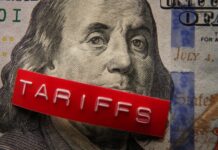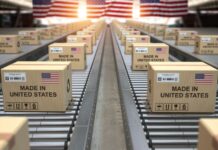This week, President Donald Trump finally released his “Liberation Day” tariffs. Trump has long threatened that he would, if given the chance, levy massive tariffs on imported products from the rest of the world. The question for investors, however, was just what was driving such threats. Was it a desire to leverage other countries into lowering their own trade barriers? Or was it protection of national security interests? Or did Trump merely have a zero-sum view of the global economy in which trade impoverishes the United States while enriching other countries?
Well, now we have our answer.
The tariffs levied by Trump this week certainly provide clarity. As Trump put it in the White House Rose Garden, “We’re going to be wealthy as a country because they’ve taken so much of our wealth away from us.”
Just in case the message wasn’t obvious from his verbiage, it became crystal-clear from the gigantic chart Trump held up. That chart contrasted the supposed “Tariffs Charged to the USA Including Currency Manipulation and Trade Barriers” with “USA Discounted Reciprocal Tariffs.” But the chart didn’t actually carry the tariff rates other countries charge us. Instead, it listed false tariff rates created by taking our trade deficit with a country and calculating that number against that country’s imports from the United States. For example, the actual South Korean average tariff rate on American goods is approximately 0.79%, based on the Korea-US Free Trade Agreement. The chart, however, lists the South Korean tariff rate as 50%. That’s calculated by taking our trade deficit with South Korea ($66 billion) and dividing it by South Korean imports ($131.5 billion).
Trade deficits often result from imbalances in the wealth of the countries involved, not from unfair tariff regimes: The U.S. imports much more from South Korea than it exports to South Korea because our market is larger and richer. Yet South Korea is slapped with a 25% “reciprocal tariff,” while Brazil, which imposes a 5.8% average tariff rate on American goods but has a trade deficit with us, is hit with only a 10% tariff. This is economically nonsensical.
There are consequences to such policy.
First off, countries unable to trade with the United States are likely to take their business elsewhere — primarily to the massive market that is China. That’s particularly true of our erstwhile Southeast Asian allies and colleagues, whom we are slamming with outsized tariffs: South Korea (25%), Vietnam (46%), Cambodia (49%), Malaysia (24%), Thailand (36%), Taiwan (32%) and Indonesia (32%), among others. But it’s also true of countries like Canada as well as the European Union. If we won’t trade with them, others will.
Then there’s the question of America’s economic health. Taxing imports increases prices.
Yes, there will be some substitution of domestic production for importation, but those goods will be more expensive — and over time, they will grow less competitive in price and quality. This is precisely what happened to the American auto companies in the 1950s and 1960s, leading to their subsequent collapse. Consumers will pay more. And that’s best-case scenario. For many companies, consumers will simply stop buying at elevated prices.
Meanwhile, retaliatory tariffs from other countries — especially since those countries are now convinced that Trump is not looking for concessions on their tariff rates — are likely.
Which means that some domestic American companies will have their own export markets
frozen or destroyed.
As America withdraws economically within her own borders, citizens outside of key protected industries are not likely to feel the benefit. They are likely to pay more for worse goods. They may experience job loss as their companies lose their markets. And as America’s role in the world shrinks, so, too, may the status of the dollar as the world’s reserve currency — a key factor in ensuring that America’s massive and growing national debt does not sink the economy completely.
Now, Trump is unlikely to carry his policies to their full fruition if markets respond as expected. He is too canny a politician for that. In fact, he is already carving out certain industries from his tariff regimes, including industries he supposedly wants to reshore (semiconductors being a prime example). But markets loathe uncertainty and vacillation.
One can only hope that Trump reads the tea leaves if the markets respond as expected — and that he returns to his history as a pro-business, pro-markets president as soon as possible.































